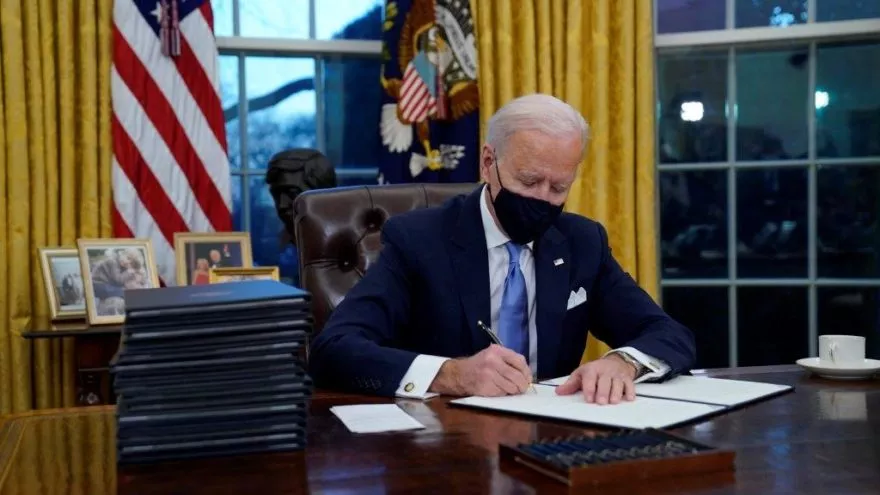From day one, President Joe Biden has been working with educators to address the pandemic and systemic racism, aid our school communities, and support the labor movement across the country. Along with Dr. Jill Biden and Secretary-designate Miguel Cardona, President Biden has made efforts to lift up educators’ voices in the White House and the Department of Education, providing more support than ever for educators, students, and families.
“Educators are encouraged not only by President Biden’s leadership but also by knowing that there is finally a true partner in the White House who will prioritize students by working with educators in the decision-making process,” said NEA President Becky Pringle.
When educators stand up and turn out for elections, they make their voices heard. President Biden and his administration have been listening. Starting on Inauguration Day, Jill Biden spoke with educators to express her gratitude for the efforts educators took to ensure pro-public education candidates were elected and legislation was passed.
“I couldn’t wait one more day to have this meeting, to say thank you on behalf of a grateful nation, to educators for their heroic commitment to students during this pandemic. You’ve been so strong, and we will be strong in our support for you,” said Dr. Biden. “Educators, this is our moment, because we know how to turn chaos into something beautiful – we do it every day in our classrooms.”
The new administration is making it clear that they will work with educators to safely bring students back into school buildings, and address educational inequities that have been exacerbated by the COVID-19 pandemic. Through executive orders, Biden has begun to execute his plans to address the pandemic, reverse some of the Trump administration’s most damaging policies, and help K-8 schools resume in-person learning. In addition, he is urging Congress to pass a $1.9-trillion coronavirus relief and stimulus package that includes $130 billion in dedicated funding for schools, $350 billion in state and local aid, and $35 billion in emergency funds for colleges.
Here is what some of his executive orders mean for students and educators:
Biden outlined a Racial Equity plan to support students
As educators, we continue to work every day for education justice for our students and our nation. President Biden’s executive orders related to COVID response have directly tasked departments to track data related to how students from families with low incomes, students of color, English-language learners, students with disabilities, and others have been impacted. Additionally, the order ensures an equitable pandemic response and recovery by expanding community-based healthcare workers via a COVID-19 Health Equity Task Force(HETF) to assist with contract tracing, vaccination, and linkage to care. These actions will also support Native communities through the pandemic.
President Biden also released a memorandum that condemned racism and xenophobia directed toward Asian Americans and Pacific Islanders. He called for agencies to coordinate with the HETF to support cultural competency and sensitivity toward the community in the federal government’s response to the COVID-19 pandemic.
He directed action to safely reopen school buildings
President Biden directed the Departments of Education and Health and Human Services to provide science-based guidance on the safe reopening and operation of schools, child care providers, and institutions of higher education. His administration will work to ensure that testing materials, support for contact tracing, PPE, and vaccinations for educators are equitably provided to support in-person care and learning. Additionally, the order encourages the Federal Communications Commission to increase connectivity options for students lacking reliable home broadband, so that they can continue to learn if their schools are operating remotely.
He affirmed the rights of LGBTQ+ students and educators
“Children should be able to learn without worrying about whether they will be denied access to the restroom, the locker room, or school sports,” said President Biden. Following the executive order, Secretary-designate Miguel Cardona also affirmed that within the Department of Education, he would also protect the rights of all students, including transgender students.
He deferred student loan payments
In an effort to aid borrowers during the pandemic and support students interested in pursuing higher education, Biden deferred student loan payments at least until September 31, 2021. He has also supported the idea of canceling a portion of student loan debt and is considering steps including via executive order or through support of Congress. These actions are a step toward securing high quality, affordable, and accessible higher education for all Americans.
He restored collective bargaining rights for federal employees
President Biden’s executive order supports the rights of federal workers around the country. In a tweet following the announcement, he said, “Every American deserves the dignity and respect that comes with the right to union organize and collectively bargain. The policy of our government is to encourage union organizing, and employers should ensure their workers have a free and fair choice to join a union.”
He reversed damaging, cruel immigration policies
The Biden administration unveiled a robust and urgent plan which delivered on promises made to immigrant communities during the campaign. Actions include lifting the Muslim travel ban, extending protections to DACA recipients—including an estimated 15,000 educators, their students, and families—and keeping families together.
Within the first week in office, President Biden also sent Congress the U.S. Citizenship Act, a comprehensive immigration reform bill providing an eight-year path to citizenship for undocumented people living in the United States.
He reopened enrollment for the Affordable Care Act
Benefitting educators and 9 million other working Americans who have experienced layoffs or economic hardship due to the COVID-19 pandemic, Biden reopened ACA enrollment between Feb. 15 and May 15, 2021.

